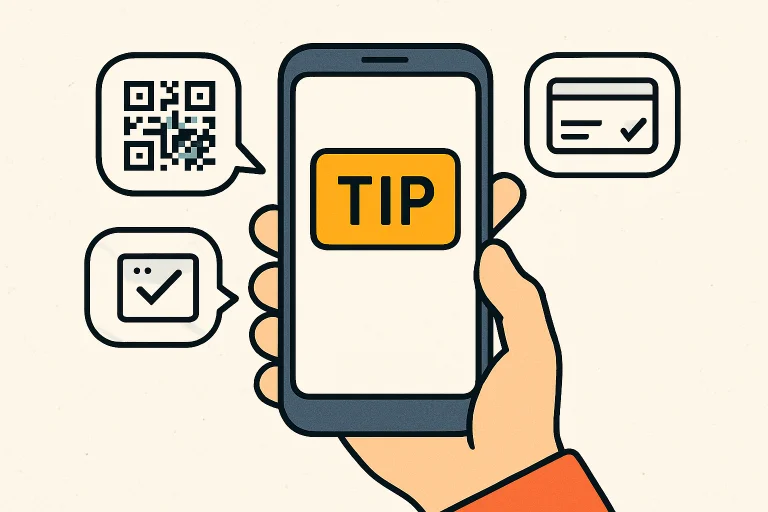Key Takeaways:
- Digital tipping platforms are transforming gratuity practices, enhancing convenience and transparency.
- Technological advancements in tipping software are improving tip distribution and compliance.
- Consumer attitudes toward tipping are evolving, influenced by digital payment methods and economic factors.
Table of Contents:
- Introduction
- The Rise of Digital Tipping Platforms
- Enhancing Tip Distribution and Compliance
- Consumer Attitudes and ‘Tipflation’
- Impact on the Hospitality Industry
- Future Trends in Tipping Software
- Conclusion
Introduction
The norms and logistics of tipping are rapidly evolving due to the widespread adoption of digital technology. Consumers and businesses alike are gravitating toward digital solutions that streamline gratuity distribution and bring new visibility to the process. Today’s service economy is increasingly dependent on systems that facilitate the easy, secure, and quick transfer of tips, underscoring the rise of advanced tip pooling software as a standard industry tool.
These technological advances in tipping have opened doors to greater accountability and satisfaction, providing both customers and employees with a more seamless experience. Businesses are also leveraging digital tipping, not only to increase compliance with labor regulations but also to boost morale and demonstrate fairness in compensation, creating a modernized approach to service industry rewards.
Dive deeper into insights that can transform your business strategy today.
The Rise of Digital Tipping Platforms
COVID-19 dramatically accelerated the adoption of contactless payments and digital tipping systems. Customers now expect to have the option to tip using mobile apps, QR codes, and other digital channels, reducing the need for physical cash and minimizing the potential for hygiene issues. Digital tipping platforms have proven especially popular in cafes, rideshare services, hotels, and salons industries where customer convenience directly correlates with positive service experiences.
The digital payment trend is transforming workplace culture and service expectations. Restaurants, for example, increasingly equip staff with handheld devices to accept both payments and tips at the table. As these solutions become standard, digital gratuities are now being recorded, tracked, and distributed more efficiently than ever before, creating new opportunities for data analysis and insights into customer behavior.
Enhancing Tip Distribution and Compliance
Tipping software has a profound impact on the fairness and transparency of tip distribution. Traditionally, manual tip tracking led to errors, disputes, and sometimes inequitable sharing among staff. Automated digital platforms ensure that every tip is recorded and allocated according to predetermined rules whether it’s split among a team or directed to specific individuals based on hours worked or roles. This automation supports compliance with local regulations and labor laws, which are strict about how tips are reported and taxed.
Integration with payroll and timekeeping software further simplifies compliance and audit trails for employers. Many modern platforms offer instant tip payouts, enabling workers to access their earnings immediately rather than waiting for a weekly paycheck. According to a report by The Wall Street Journal, these features are increasingly prioritized by younger workers, who value both transparency and flexibility in how their compensation is managed.
Consumer Attitudes and ‘Tipflation’
As digital tipping becomes more prevalent, consumers are encountering prompts to tip in a broader range of situations. Kiosks, delivery services, and even retail counters often request tips, giving rise to the term “tipflation” as amounts and expectations increase. While this trend enables service workers to earn more, it can also create discomfort or fatigue among customers who worry about overspending or being judged for declining services.
To address these concerns, some businesses have revisited their tipping policies or clarified suggested tip amounts at checkout. Consumer research, as reported in The New York Times, indicates that customers value transparency and guidance, which helps maintain goodwill in service transactions while ensuring that workers are fairly compensated.
Impact on the Hospitality Industry
Nowhere is the effect of tipping software more pronounced than in the hospitality industry. Hotels and restaurants have swiftly adopted digital tipping as a means to cater to evolving social norms and improve service. For example, hotels offering QR code tipping cards in guest rooms have seen notable increases in tips to housekeeping staff departments that often relied heavily on cash tips and previously received little recognition. This uplift not only boosts employee morale but also drives better guest reviews, higher staff retention, and an overall superior guest experience.
Transforming Operations at Scale
Large hospitality brands are now integrating their tipping systems with broader property management solutions, utilizing analytics to optimize staffing and recognize top performers. Meanwhile, independent restaurants can create more equitable tip pools that reward all contributing staff, thereby reducing tension and promoting greater equality. By fully digitizing tips, the industry achieves higher transparency and legal compliance, protecting both business owners and their workforce.
Future Trends in Tipping Software
The future of tipping software is expected to bring even greater personalization, automation, and connectivity. Advanced algorithms will analyze factors such as service quality, customer history, spending patterns, and regional tipping norms to suggest fair and customized tip amounts. These systems can also integrate seamlessly with digital wallets, payroll systems, and banking apps, enabling instant deposits and enhanced financial transparency. Beyond convenience, emerging platforms will help service workers manage their income more effectively offering tools for budgeting, saving, and investing tips. This evolution not only simplifies transactions but also promotes financial stability and empowerment within the service industry.
Expanding Applicability Across Industries
Innovations in tipping technology are expected to extend to sectors beyond hospitality, such as healthcare, education, and gig economy platforms. Regular software updates will further optimize security, data privacy, and compliance functions—helping businesses and workers navigate evolving regulations and customer expectations.
Conclusion
The adoption of tipping software is transforming how businesses handle gratuities, introducing efficiency, fairness, and accuracy to an area that has long been prone to errors and disputes. These digital systems automate tip tracking and distribution, ensuring employees are compensated fairly and consistently based on performance and hours worked. For employers, they simplify compliance with labor laws and reporting requirements, while offering real-time visibility into payments. Customers also benefit from greater transparency, knowing their tips reach the intended recipients. As technology advances, tipping software continues to refine the management of gratuities, paving the way for a more balanced, transparent, and accountable tipping culture across various industries.
Discover top stories and tips that are shaping your industry right now.






